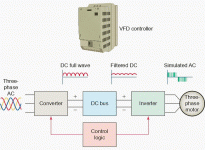caribconsult
Senior Member
- Location
- Añasco, Puerto Rico
- Occupation
- Retired computer consultant
Almost all the current room air conditioners are now min-splits, which is great because it puts the main noice outside. But why do they have and inverter? An inverter converts DC to AC, and since's already AC (usually 220) already there, what's the purpose of this inverter? Is it really a rectifier and just using the wrong name? Converting the line AC to DC and using that to control the compressor moter maks sense. But you don't use an inverter to do that, it requires a rectifier. Somebody here have the answer?

